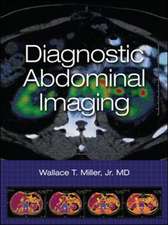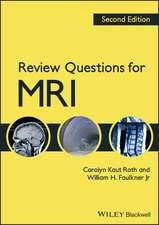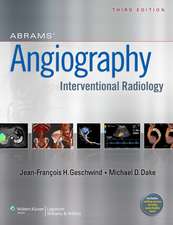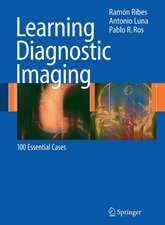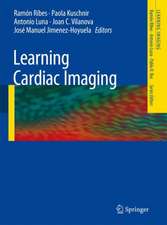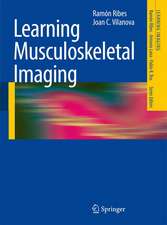Small-Animal SPECT Imaging
Editat de Matthew A. Kupinski, Harrison H. Barretten Limba Engleză Hardback – 20 iun 2005
| Toate formatele și edițiile | Preț | Express |
|---|---|---|
| Paperback (1) | 1426.05 lei 38-44 zile | |
| Springer Us – 7 dec 2010 | 1426.05 lei 38-44 zile | |
| Hardback (1) | 1605.36 lei 6-8 săpt. | |
| Springer Us – 20 iun 2005 | 1605.36 lei 6-8 săpt. |
Preț: 1605.36 lei
Preț vechi: 1689.85 lei
-5% Nou
Puncte Express: 2408
Preț estimativ în valută:
307.22€ • 333.60$ • 258.07£
307.22€ • 333.60$ • 258.07£
Carte tipărită la comandă
Livrare economică 22 aprilie-06 mai
Preluare comenzi: 021 569.72.76
Specificații
ISBN-13: 9780387251431
ISBN-10: 038725143X
Pagini: 294
Ilustrații: XXII, 294 p. 123 illus.
Dimensiuni: 155 x 235 x 20 mm
Greutate: 0.58 kg
Ediția:2005
Editura: Springer Us
Colecția Springer
Locul publicării:New York, NY, United States
ISBN-10: 038725143X
Pagini: 294
Ilustrații: XXII, 294 p. 123 illus.
Dimensiuni: 155 x 235 x 20 mm
Greutate: 0.58 kg
Ediția:2005
Editura: Springer Us
Colecția Springer
Locul publicării:New York, NY, United States
Public țintă
ResearchDescriere
Small-Animal SPECT Imaging is an edited work derived from the first workshop on Small-Animal SPECT Imaging held January 14-16, 2004 at the University of Arizona, Tucson, AZ, USA. The overall goal of the meeting and therefore this volume is to promote information exchange and collaboration between the research groups developing systems for small-animal applications. Topics include the biomedical significance of small-animal imaging, an overview of detector technologies including scintillation cameras and semi-conductor arrays, imager design and data acquisition systems, animal handling and anesthesia issues, objective assessment of image quality, and system modeling and reconstruction algorithms.
Cuprins
- Preface -Biomedical Significance of Small-Animal Imaging -Detectors for Small-Animal SPECT I -Detectors for Small-Animal SPECT II -The Animal in Animal Imaging -Objective Assessment of Image Quality -SPECT Imager Design and Data-Acquisition Systems -Computational Algorithms in Small-Animal Imaging –Reconstruction Algorithm with Resolution Deconvolution in a Small-Animal PET Imager –Estimates of Axial and Transaxial Resolution for One-, Two-, and Three-Camera Helical Pinhole SPECT –Pinhole Aperture Design for Small-Animal Imaging –Comparison of CsI(Ti) and Scintillating Plastic in a Multi-Pinhole/CCD-Based Gamma Camera for Small-Animal Low-Energy SPECT –Calibration of Scintillation Cameras and Pinhole SPECT Imaging Systems –Imaging Dopamine Transporters in a Mouse Brain with Single-Pinhole SPECT –A Micro-SPECT/CT System for Imaging of AA-Amyloidosis in Mice –Feasibility of Micro-SPECT/CT Imaging of Atherosclerotic Plaques in a Transgenic Mouse Model –Effect of Respiratory Motion on Plaque Imaging in the Mouse Using Tc-99m Labeled Annexin-V –Calibration and Performance of the Fully Engineered YAP-(S)PET Scanner for Small Rodents –A Small-Animal SPECT Imaging System Utilizing Position Tracking of Unanesthetized Mice –A Multidetector High-Resolution SPECT/CT Scanner with Continuous Scanning Capability –High-Resolution Multi-Pinhole Imaging Using Silicon Detectors –Development and Characterization of a High-Resolution MicroSPECT System –High-Resolution Radionuclide Imaging Using Focusing Gamma-Ray Optics –SPECT/Micro-CT Imaging of Bronchial Angiogenesis in a Rat –Projection and Pinhole-Based Data Acquisition for Small-Animal SPECT Using Storage Phosphor Technology -Index
Textul de pe ultima copertă
Small-Animal SPECT Imaging offers a comprehensive overview of the cutting edge imaging tool that can aid in drug development, drug research, molecular imaging, and imaging science. It represents contributions of the world's leading researchers in small-animal SPECT imaging, providing coverage from the basic physics of SPECT imaging to animal studies. Important integrated sections on animal handling, image quality assessment, and reconstruction algorithms are included, allowing its audience to design and run their own studies.
Key Features:
Scintillation and semiconductor detector technologies
Digital signal processing techniques
System modeling and reconstruction algorithms
Animal monitoring and handling, including anesthesia issues
Applications of small-animal imaging
Detailed sections on animal handling, image assessment, and reconstruction algorithms -allow readers to implement their own tailored studies
Small-Animal SPECT Imaging is aimed at researchers performing imaging to study the effects of drugs, molecular agents, and treatments, including molecular imaging scientists, imaging scientists; nuclear medicine researchers, and all those interested in the application of SPECT systems in the areas of cancer research, cardiovascular research, and gene therapy
About the Editors:
Matthew A. Kupinski is an Assistant Professor of Optical Sciences and Radiology at the University of Arizona. He earned his Ph.D. from the University of Chicago in 2000 and joined the faculty at the University of Arizona in 2002.
Harrison H. Barrett is a Regents Professor of Radiology and Optical Sciences at the University of Arizona in Tucson, Arizona. Professor Barrett joined the University of Arizona in 1974, is the former editor of the Journal of the Optical Society of America A, and is the recipient of the IEEE Medical Imaging Scientist Award in 2000. He is the coauthor of two books on image science.
Key Features:
Scintillation and semiconductor detector technologies
Digital signal processing techniques
System modeling and reconstruction algorithms
Animal monitoring and handling, including anesthesia issues
Applications of small-animal imaging
Detailed sections on animal handling, image assessment, and reconstruction algorithms -allow readers to implement their own tailored studies
Small-Animal SPECT Imaging is aimed at researchers performing imaging to study the effects of drugs, molecular agents, and treatments, including molecular imaging scientists, imaging scientists; nuclear medicine researchers, and all those interested in the application of SPECT systems in the areas of cancer research, cardiovascular research, and gene therapy
About the Editors:
Matthew A. Kupinski is an Assistant Professor of Optical Sciences and Radiology at the University of Arizona. He earned his Ph.D. from the University of Chicago in 2000 and joined the faculty at the University of Arizona in 2002.
Harrison H. Barrett is a Regents Professor of Radiology and Optical Sciences at the University of Arizona in Tucson, Arizona. Professor Barrett joined the University of Arizona in 1974, is the former editor of the Journal of the Optical Society of America A, and is the recipient of the IEEE Medical Imaging Scientist Award in 2000. He is the coauthor of two books on image science.
Caracteristici
Small-animal SPECT is a relatively new imaging tool that can aid in drug development, drug research, molecular imaging, and imaging science
Presents cutting-edge research in these areas as well as an overview of modern small-animal SPECT systems. Everything from the basic physics of SPECT imaging to animal studies are presented. Sections on animal handling, image quality assessment, and reconstruction algorithms are also included to help researchers design and run their own studies
Includes supplementary material: sn.pub/extras
Presents cutting-edge research in these areas as well as an overview of modern small-animal SPECT systems. Everything from the basic physics of SPECT imaging to animal studies are presented. Sections on animal handling, image quality assessment, and reconstruction algorithms are also included to help researchers design and run their own studies
Includes supplementary material: sn.pub/extras

